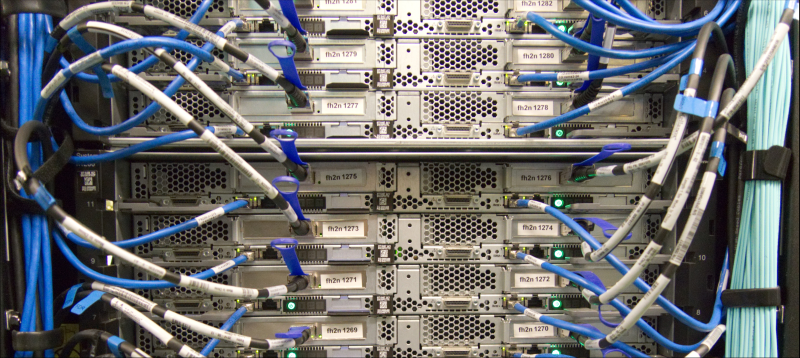
A scratch in the screen, a moderate battery life or a full hard drive. For many, these are valid reasons to discard equipment. Is that sensible? And what about the invisible mountain of waste caused by the cloud?
Maikel Dijkhuizen

An average person in the western world An average person in the western world owns a smartphone, tablet, computer and a smart TV. A monitor, smartwatch, e-reader, game console, external hard drive and/or printer may also be added. Plus all the electrical appliances we haven’t mentioned yet. With every small change, some people are quickly inclined to replace this ‘defective’ device. And that while the device may be easy to upgrade or repair. Part of this has to do with convenience. After all, why repair (for a fee) when a new cheap one is within reach with a few mouse clicks or screen taps? Yet we all have an interest in limiting digital overconsumption. This applies both to the handling of physical devices and to the massive need for data storage.
ECOLOGICAL FOOTPRINT
Electronics contain all kinds of rare metals and other raw materials. Partly due to digital overconsumption, we are rapidly depleting our planet. Earth Overshoot Day therefore falls a little earlier almost every year. This is the day when global society has consumed as many raw materials and foodstuffs as our globe can produce in one year. so fell Earth Overshoot Day in 2021 already on July 29. According to calculations by the independent non-profit organization Global Footprint Network, humanity has a combined ecological footprint of 1.75 Earths. The almost infinite need for digital devices plays a significant role in this. In addition to precious raw materials, the production of new products also requires a lot of water and energy.
 |
| Data centers create a huge invisible mountain of digital waste that keeps growing |
USE DEVICES LONGER
To somewhat limit the mining of fossil raw materials and energy consumption, it is essential to use devices for as long as possible. Do you necessarily want another smartphone with the latest technical gadgets or can the current device last for another year? In fact, everyone should ask themselves this question with every electrical appliance. Companies also have a responsibility in this regard. Often, the purchase of a new device is not or hardly more expensive than the repair of an existing device outside the warranty period. Make repair services cheaper to encourage more sustainable use of devices. Even better would be that consumers are entitled to free repairs during the lifetime of, for example, a smartphone or tablet.
Fortunately, there are also good developments. So are so-called refurbished products are widely available at all kinds of (web) stores. In short, these are fixers that have been used before. This often concerns parties from the business market. Many companies write off computers, laptops and smartphones after a few years. They can usually easily last a while. After a thorough cleaning and checking of all hardware, such devices end up on sale at a reduced rate.
Another good development is that a number of Android smartphone manufacturers offer software support for much longer. For example, Samsung now offers four years of Android updates and five years of security updates for a number of Galaxy devices. Other providers such as Oppo and Xiaomi also offer longer support for a number of smartphones.
HIDDEN WASTE
In addition to discarding devices too quickly, the ever-growing need for data also leads to more and more waste. That’s just invisible. The cloud is indeed on Earth. Just think of all those energy-guzzling data centers that store our videos, photos, emails and documents. Tech giants like Google, Microsoft, Apple and Amazon store our data all over the world. Numerous hard drives are required for this. These disks regularly break, after which employees of server farms replace them with new ones.
Our planet benefits from drastically reducing the amount of data stored. It is therefore extra wry that people never open the vast majority of their personal files again. This also applies to companies. They also generate enormous amounts of data that they never have to worry about again. In short, a huge waste! Photos and videos are also increasing in size due to the increasingly higher resolutions. That only leads to a growing demand for server capacity. For example, there are concrete plans for new server parks in North Holland and Groningen in the Netherlands alone.
GET STARTED: REDUCE DATA STORAGE
Everyone can contribute to capping the invisible digital waste mountain. That is actually quite simple. Take a thorough sweep through your mailbox and immediately throw away unimportant messages from now on. In addition, be critical about which photos and videos you store on online services such as Microsoft OneDrive, Apple iCloud and Google Drive. Also consider the quality of your snapshots. For example, the new Samsung Galaxy S22 supports a dizzying camera resolution of 50 megapixels. You only benefit from that if you print the images in almost billboard size. So it makes no sense to store all your precious memories in such high quality. After all, you usually view photos on a digital device with a modest screen. So feel free to set a lower quality on your smartphone to reduce your digital footprint.
In addition to consumers, companies can of course also limit their data storage. Both small and large organizations maintain servers for their data. Or they outsource this task to a commercial cloud service. Governments have a task to create awareness. If we want to leave a livable planet for our (grand)children, then it is high time to put a stop to our joint data addiction. This may even require a tax on digital data in the near future. An unpleasant prospect, but we cannot go on like this indefinitely.